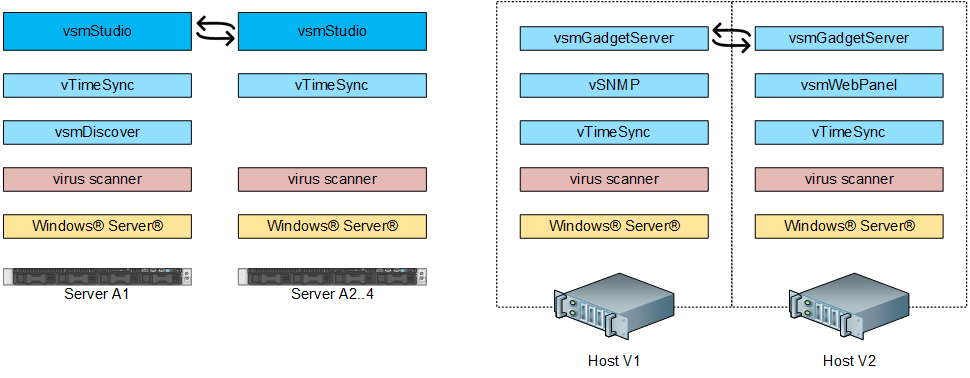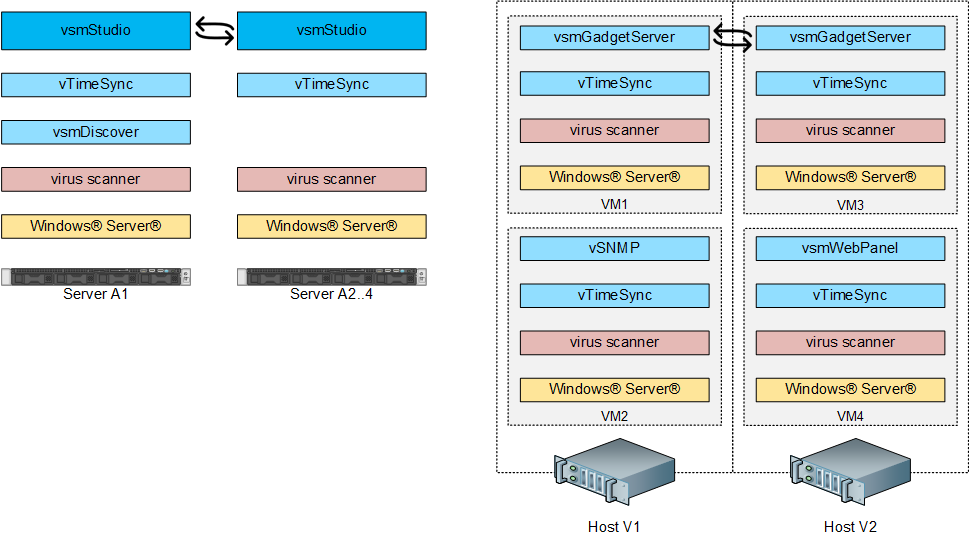VSM - Topology and Service Virtualization
vsmSoftware - Topology
VSM is a family of products, which consists of the main component vsmStudio and a set of contributing components, such as vsmGadgetServer and vSNMP. Some of the components of VSM have specific requirements towards the host platforms they run on, to guarantee highest availability and reliability in a 24/7/365 live production environment. For vsmStudio as operation critical component, Lawo offers a specific server platform. This platform is usually ordered ready-made as operable server system with vsmStudio pre-installed. The platform is specified to meet operational requirements of all VSM installs, with a focus on high availability at high load.
As high load, Lawo understands e.g. switching of large amounts of cross points "at the top of the hour", processing extensive tie-line calculations when switching salvos, or recalling of large storage groups. vsmStudio is designed to run demanding processes in ultra-low latency on a Windows Server, and the specified servers are built to support this.
The server platform is specified to host one single instance of vsmStudio, but no concurring applications. This way, vsmStudio owns all system resources to ensure maximum availability. Potentially concurring applications include other VSM components, such as vsmGadgetServer or vSNMP. They are not allowed to run concurrently on a vsmStudio server. Instead, VSM components must reside on hosts separate from the vsmStudio servers.
The following scheme outlines a typical setup of a VSM install. vsmStudio instances are hosted on separate servers each. Up to 4 physical machines can build a vsmStudio server cluster (Server A1 … A4). On each server, vTimeSync is recommended to run as a service to keep all machines in synch to a global time source. Optional security tools like virus scanners or firewalls can be installed per server, but must be operated according to the recommendations in the "Product Information - Server and IT Specifications". It is also allowed to install and run applications which are not operation-critical on these servers (e.g. vsmDiscover), but it is mandatory to shut them down during 24/7 operations.

vsmSoftware - Service Virtualization
This chapter refers to virtualizing VSM components, like vsmGadgetserver, vSNMP, vsmWebPanel, etc. It does not apply to the virtualization of the core component vsmStudio.
It is possible to virtualize Server B1 and B2 (picture below: Host V1 Host V2), for example to save rackspace, energy and weight, or to provide further resources. However, it must be guaranteed by configuration, that applications like vsmGadgetServer, vSNMP, or vsmWebPanel, can access all resources they need at any time. As these services are operation critical, using resources concurrently by other applications will cause VSM components and ultimately vsmStudio to slow down.

The example above can be elaborated into a more advanced setup, as host servers may provide enough resource to allow for a more differentiated setup. If resources are available to support various virtual machines on the same host, a possible setup can focus on the separation of services.

The example above enables a proper service separation, which does not only allow for a transparent maintenability of single virtual machines without affecting others. Host resources can also be customed across all services in order to meet individual service requirements.